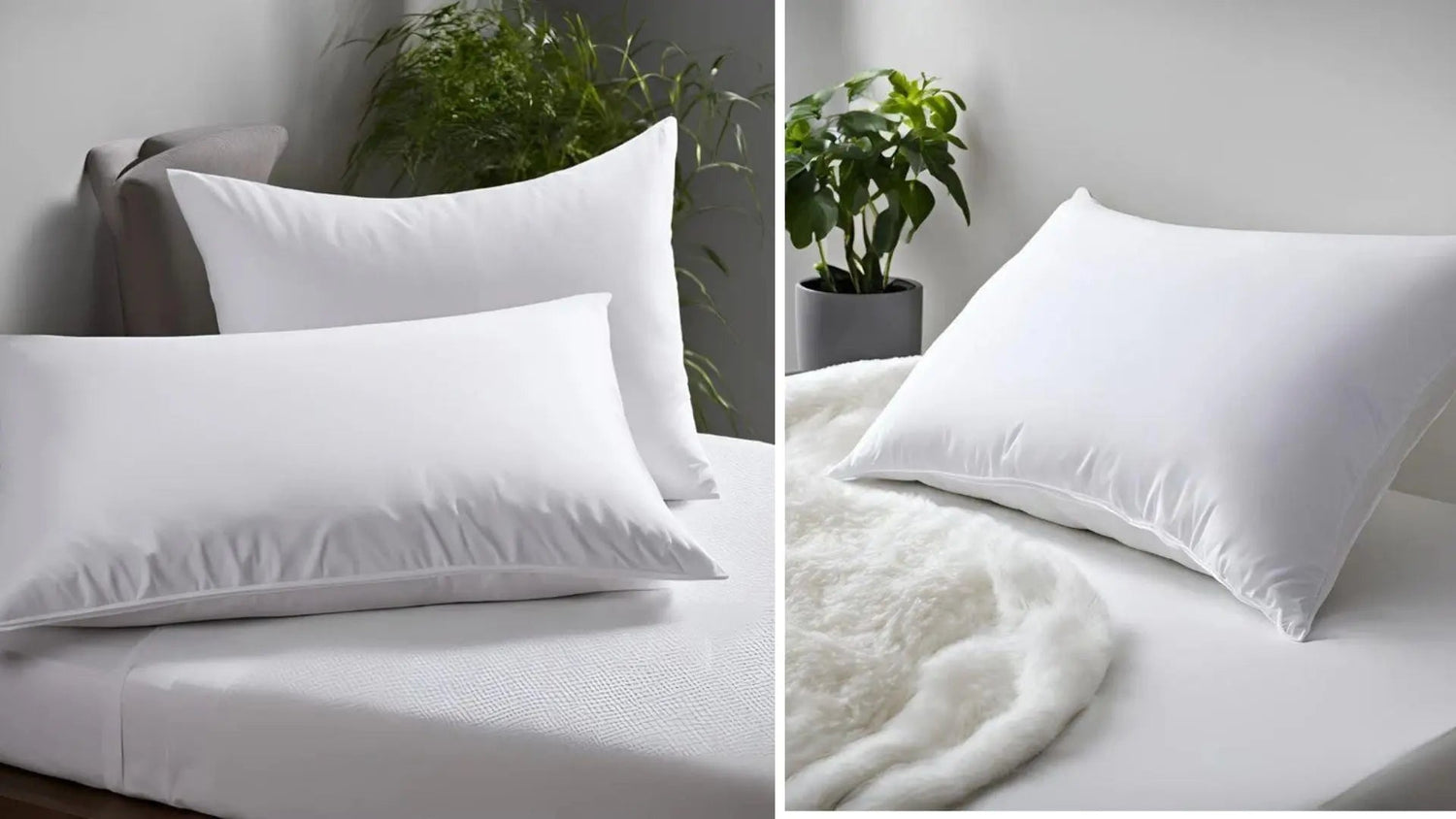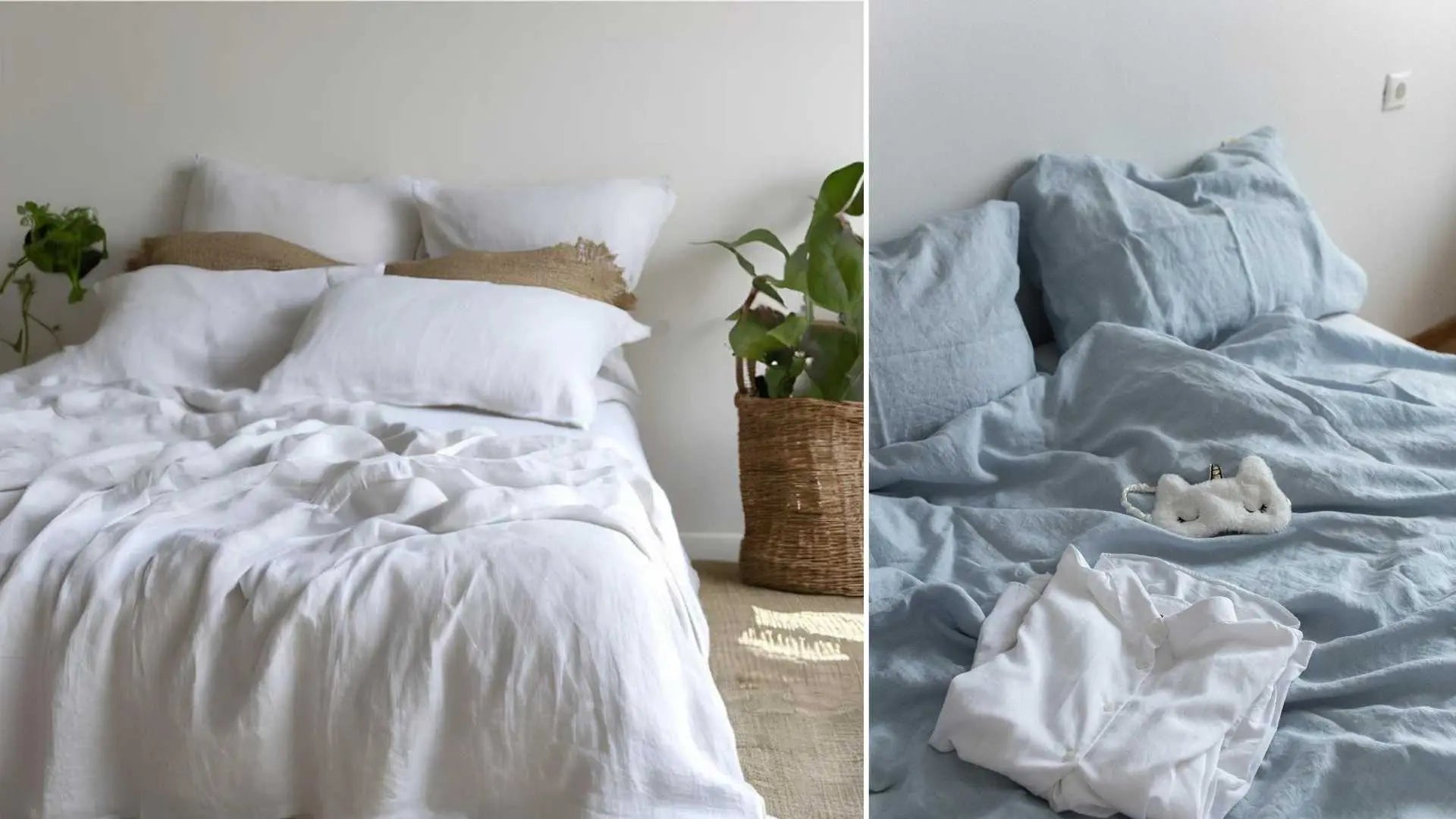Pillows are an essential part of your sleep environment, yet they often get overlooked when it comes to cleaning. Over time, they accumulate sweat, oils, dead skin cells, and allergens, which can affect their hygiene, comfort, and lifespan. Washing your pillows regularly ensures better sleep hygiene and helps maintain their structure and loft.
This guide will take you through step-by-step instructions, tailored care techniques for various pillow types, and tips on avoiding common mistakes to ensure your pillows stay fresh, clean, and comfortable.
Why Wash Your Pillow Regularly?
1. Eliminating Allergens and Dust Mites
Pillows are a breeding ground for dust mites, which can trigger allergies, asthma, and other respiratory issues.
Properly washing pillows at temperatures above 130°F (54°C) kills dust mites and removes their accumulated waste products.
This reduction in allergen load can significantly improve symptoms for the estimated 20 million Americans who suffer from dust mite allergies
2. Removing Odors
Sweat, body oils, and environmental factors can cause pillows to develop unpleasant smells over time.
Human bodies emit various compounds during sleep:
- Volatile fatty acids from sweat
- Sebum from skin oils
- Squalene and other lipids
- Environmental pollutants released through perspiration
Proper washing removes these compounds and their associated odors, restoring freshness to your sleeping environment.
3. Prolonging Pillow Lifespan
Regular cleaning prevents the buildup of oils and particles that can mat down filling materials, helping pillows maintain their proper loft and support characteristics.
This translates to better neck and spinal alignment during sleep.
4. Improved Sleep Quality Through Hygiene
Sleep science increasingly recognizes the connection between environmental cleanliness and sleep architecture.
Research from the National Sleep Foundation reveals that 75% of people report sleeping better on clean sheets and pillows, with measurable improvements in:
How to Wash Pillows Based on Material

Different pillow types require specific care methods to ensure their quality and performance remain intact.
1. Memory Foam Pillows
Memory foam consists of polyurethane enhanced with additional chemicals to increase density and viscosity. This structure creates the characteristic contouring effect but makes the material highly susceptible to water damage
Step-by-Step Cleaning Process:
- Preparation:
- Remove all pillowcases and protective covers
- Vacuum the pillow surface using a handheld vacuum with upholstery attachment on low suction
- Inspect for visible stains or soiled areas
-
Spot Treatment Method:
- 1 tablespoon mild, enzyme-free detergent
- 2 cups warm water
- Create a gentle cleaning solution using:
- Dampen a clean white cloth (colored cloths may transfer dye)
- Gently blot stained areas without saturating the foam
- Use circular motions working from the outside in
-
Deep Refreshing Process:
- 1 cup distilled water
- ¼ cup white vinegar
- 5-10 drops essential oil (optional—lavender, tea tree, or eucalyptus recommended)
- Create a deodorizing spray by mixing:
- Lightly mist the pillow surfaces (do not saturate)
- Sprinkle baking soda over the entire pillow
- Let sit for 1-2 hours in a well-ventilated area
- Thoroughly vacuum all surfaces to remove baking soda
- Drying and Refreshing:
- Air dry completely in a well-ventilated area
- Place in direct sunlight for 2-3 hours if possible (UV rays have natural sanitizing properties)
- Ensure pillow is completely dry before replacing covers
- Special Tip: Use a removable, machine-washable pillow cover to reduce the need for frequent deep cleaning.
2. Polyester Pillows
Polyester and other synthetic fills (including down alternatives) consist of manufactured fibers designed to mimic the loft and softness of natural materials.
Polyester pillows are durable and easy to clean, making them ideal for machine washing.
Machine Washing Instructions:
-
Pre-Washing Assessment:
- Check for any tears or weak seams that might release filling during washing
- Repair any small holes with a few stitches before proceeding
- Pre-treat visible stains with a gentle stain remover
-
Washer Settings and Process:
- Load two pillows simultaneously to balance the washing machine
- Use warm water (not hot), approximately 100°F (38°C)
- Select gentle or delicate cycle
- Add minimal detergent—approximately 1 tablespoon of liquid detergent
- Add ½ cup of white vinegar to the rinse cycle to remove detergent residue
- Run an extra rinse cycle to ensure all detergent is removed
-
Detailed Drying Instructions:
- Place in dryer on low heat setting
- Add 3-4 dryer balls or clean tennis balls wrapped in white socks
- Stop the dryer every 15-20 minutes to manually fluff and redistribute filling
- Continue until completely dry—usually 2-3 cycles, depending on pillow thickness
- Ensure the pillow is 100% dry by checking the inner core for dampness
Recommended Product: Keep your cleaning routine simple with the Microfibre Pillow – Medium, designed for easy maintenance.
3. Feather and Down Pillows
Feather and down pillows require careful handling to avoid damaging the delicate filling.
Specialized Washing Process:
- Pre-Wash Inspection:
-
- Check fabric shell for integrity—any small tears can release feathers
- Examine for dark spots that may indicate mold or mildew (if present, consult a professional cleaner)
- Compress the pillow to check for musty odors which may require additional treatment
- Washing Machine Selection:
-
- Front-loading machines are strongly preferred
- If using a top-loading machine, ensure it has no central agitator which can damage the pillow
- Washing Method:
-
- Use cool to lukewarm water (never hot)
- Select the gentlest cycle available
- Use a specialized down-safe detergent that rinses completely (regular detergents can leave residue that coats feathers)
- Load two pillows to maintain washer balance
- Run two complete rinse cycles to ensure all soap is removed
-
Critical Drying Technique:
- Use lowest heat setting on dryer
- Add 3-4 wool dryer balls or clean tennis balls to prevent clumping
- Expect extended drying time—typically 2-3 hours
- Check every 30 minutes, removing and hand-fluffing
- Ensure 100% dryness throughout the pillow to prevent mold
- Following drying, allow to air out for 24 hours to ensure any remaining moisture evaporates
Pro Tip: For luxury feather pillows like the 90% Goose Down & Feather Pillow – Extra Soft, follow manufacturer care labels for best results.
4. Throw Pillows
Throw pillows are more than just decorative accents, they’re part of your daily environment, collecting dust, oils, and allergens over time.
Because they come in a variety of materials and constructions, cleaning them requires tailored approaches depending on whether the covers are removable or not
Removable Covers
- Washing Instructions:
- Start by removing the cover and checking the care label for specific guidance. Most common fabrics like cotton, polyester, or linen can handle machine washing.
- Use a gentle cycle with cold water to protect the fabric from shrinking or fading, especially if it’s patterned or brightly colored.
- Add a mild liquid detergent, about 1 tablespoon is plenty, to avoid buildup that could harm the fibers.
Skip fabric softeners, as they can leave a coating that attracts dirt over time. - For stubborn stains, pre-treat with a paste of baking soda and water or a gentle stain remover. Let it sit for 10–15 minutes before washing.
- Special Cases: If the cover is made of delicate materials like silk, velvet, or wool, hand wash it in cold water with a detergent designed for delicates, or opt for professional dry cleaning to preserve its texture.
Non-Removable Covers:
-
Spot Cleaning Technique:
- Identify the fabric type - Check care label or test cleaner on an inconspicuous area
- Blot (don't rub) any fresh spills immediately with clean, absorbent cloth
- Create appropriate cleaning solution:
- For natural fibers (cotton, linen): Mix 1 teaspoon mild detergent with 1 cup warm water
- For synthetic fibers: Use a commercial upholstery cleaner appropriate for the fabric
- For wool or silk: Use specialized wool/silk cleaners or consult professional cleaning
- For velvet: Commercial velvet cleaner with a soft brush in one direction only
-
Drying Tips:
- Air-dry removable covers to prevent shrinking.
- For non-removable pillows, place them in a well-ventilated area to dry thoroughly.
How Often Should You Wash Your Pillows?
The frequency of washing depends on how often the pillows are used and the user’s needs:
|
Pillow Type |
Frequency |
|
Sleeping Pillows |
Every 3–6 months |
|
Allergy-Prone Users |
Every 1–2 months |
|
Throw Pillows |
Every 2–3 months |
|
Pillows with Pets |
Every 1–2 months |
Pro Tip: Use washable pillow protectors and clean them every 1–2 weeks to minimize dirt and allergens on the pillow itself.
Read more about Down Pillow Myths
Step-by-Step Guide: Washing Pillows in a Washing Machine
Washing pillows in a machine can seem daunting, but with the right steps, it’s a straightforward way to refresh them.

1. Preparation
- Remove Covers: Strip off any pillowcases, protectors, or removable covers. Wash these separately on a regular cycle unless they require special care.
- Inspect for Damage: Check the pillow for tears, loose seams, or holes. Sew up small rips with a needle and thread to prevent filling from escaping during the wash.
- Spot-Clean Stains: For visible marks, apply a paste of baking soda and water or a mild stain remover. Let it sit for 15–30 minutes, then blot with a damp cloth to lift the stain without soaking the pillow.
2. Balance the Load
- Wash Two Pillows Together: Loading two pillows at once balances the washing machine, preventing it from rocking excessively and ensuring even cleaning. If you only have one pillow, add a couple of lightweight towels to even out the load.
- Avoid Overcrowding: Too many items can reduce water circulation, leaving pillows dirty or damaged. Stick to two pillows max per cycle.
3. Add Detergent
- Use Sparingly: Add just 1 tablespoon of mild, liquid detergent. Excess detergent can leave a residue that stiffens the pillow and attracts dirt over time.
- Match the Material: For synthetic pillows (e.g., polyester), a standard mild detergent works well. For feather or down pillows, opt for a down-specific detergent to protect the natural oils in the feathers and prevent clumping.
4. Select the Right Settings
- Cycle Type: Choose a gentle or delicate cycle to minimize wear on the pillow’s structure and filling.
- Water Temperature:
- Cold Water: Ideal for delicate or synthetic fills to prevent shrinkage or damage.
- Warm Water (up to 100°F / 38°C): Safe for most polyester and down pillows to tackle oils and dirt. Avoid hot water (above 130°F / 54°C) unless killing dust mites is the goal, as it can harm some materials.
- Spin Speed: Use a low or medium spin to extract water gently without stressing seams or compressing the filling.
5. Spin and Rinse
- Extra Rinse: Run an additional rinse cycle to flush out all detergent, especially crucial for feather or down pillows where residue can cause clumping.
- Spin Cycle: After rinsing, use a gentle spin to remove excess water. For extra care, pause the machine after rinsing and press the pillows by hand to squeeze out water without over-compressing them.
Pro Tip: Add ½ cup of white vinegar to the rinse cycle for a natural odor neutralizer and to help rinse away detergent more effectively.
How to Dry Pillows Safely
1. Using a Dryer
- Settings: Always use a low-heat or no-heat setting to avoid damaging the filling.
- Dryer Balls: Add dryer balls or clean tennis balls to fluff the pillows and break up clumps.
- Duration: Check pillows periodically and remove them once they’re completely dry.
2. Air-Drying
- Lay pillows flat in a sunny, well-ventilated area.
- Flip them periodically to ensure even drying.
Pro Tip: Feather and down pillows should be thoroughly dried to prevent mold or mildew.
Removing Stains and Odors from Pillows
1. Spot Cleaning Stains
- Create a paste using baking soda and water.
- Apply to the stained area and let it sit for 30 minutes before wiping clean.
2. Odor Removal Solutions
- Sprinkle baking soda over the pillow and let it sit for an hour, then vacuum off.
- Spray a mixture of water and white vinegar lightly on the pillow to neutralize odors.
Common Mistakes to Avoid When Washing Pillows

-
Overloading the Washer
- Prevents proper cleaning and can damage the washer drum.
- Solution: Wash two pillows at a time for balance.
-
Using Too Much Detergent
- Can leave residue, making the pillow stiff.
- Solution: Use only a small amount of detergent.
-
Skipping Drying Steps
- Incomplete drying can lead to mold or mildew.
- Solution: Ensure pillows are thoroughly dried before use.
-
Ignoring Care Labels
- Each pillow has specific care needs.
- Solution: Follow manufacturer instructions closely.
Read more about health benefits of Goose Down Pillows
FAQs About Washing Pillows
1. Can memory foam pillows get wet?
No, memory foam pillows should not be submerged in water. The foam absorbs moisture, which can lead to mold, mildew, or breakdown of the material. Instead, spot-clean with a damp cloth and mild detergent, then air-dry thoroughly in a well-ventilated area.
2. How do I prevent mold in pillows?
Ensure the pillows are completely dry before placing them back on your bed. Use a dryer on low heat or air-dry in a sunny spot, flipping them regularly. In humid climates, consider a dehumidifier in your bedroom or moisture-wicking pillow protectors to keep dampness at bay.
3. Should I wash my pillows before first use?
Yes, it’s a smart move! Washing removes factory residues, dust, and odors from manufacturing and shipping, giving you a clean, fresh start. Always follow the care label for the safest method.
4. Is it safe to use bleach on pillows?
Bleach is not recommended as it can weaken fibers and cause discoloration. Stick to a mild detergent and treat stains with a baking soda paste or gentle stain remover for safer, effective cleaning.
Conclusion
Washing your pillows properly at home is a simple but crucial step to maintaining sleep hygiene and extending their lifespan. By following the tailored care techniques outlined here, you can keep your pillows fresh, supportive, and allergen-free.
Ready to upgrade your bedding? Explore Raia Home’s premium pillow collection, including the 90% Goose Down & Feather Pillow – Extra Soft and Microfibre Pillow – Medium, for unmatched comfort and easy care.






Leave a comment
This site is protected by hCaptcha and the hCaptcha Privacy Policy and Terms of Service apply.